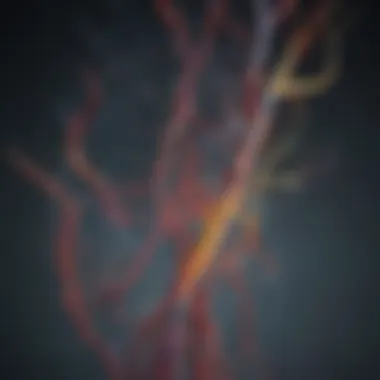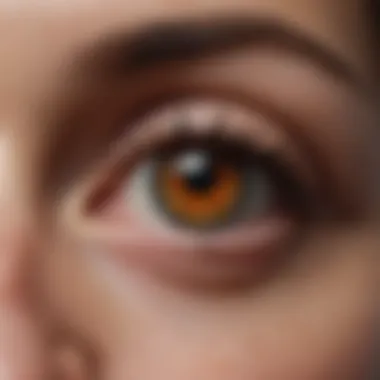Understanding Visual Epilepsy: An In-Depth Exploration


Intro
Visual epilepsy is a fascinating and complex neurological condition that has gained more attention in recent years. It is characterized by seizures that are specifically triggered by visual stimuli. This can range from patterns, lights, or even specific images, making the understanding of such triggers crucial for the management and treatment of affected individuals.
In this article, we aim to provide a comprehensive examination of visual epilepsy, delving into the mechanisms behind the condition, the symptoms commonly associated with it, and the various diagnostic and treatment options available. The impact of visual epilepsy extends beyond the seizures themselves, affecting daily life and emotional well-being. Thus, a thorough exploration of this condition is necessary to inform patients, healthcare professionals, and researchers about its complexities.
Through synthesizing current research and expert insights, this discussion will underscore the importance of ongoing research in the field while addressing the nuances and challenges associated with visual epilepsy.
Intro to Visual Epilepsy
Understanding visual epilepsy is essential for grasping the broader implications of epilepsy as a whole. This specific type of epilepsy is defined by seizures triggered by visual stimuli. The exploration of visual epilepsy has significant relevance across various domains including clinical practice, patient care, and ongoing research. It underlines the importance of recognizing visual triggers and implementing appropriate strategies.
Through a detailed examination of this condition, we can gain insights into its complex features, which aids in better diagnosis and management. The information presented will benefit students, researchers, educators, and healthcare professionals striving for a deeper comprehension of the subject.
Moreover, attending to the challenges faced by individuals with visual epilepsy enhances our understanding of the psychosocial aspects linked to the disorder.
Defining Visual Epilepsy
Visual epilepsy is a neurological condition characterized by seizures elicited primarily by visual stimuli such as flashing lights, patterns, or certain images. The reaction usually stems from abnormal activity in specific areas of the brain that process visual information, mostly in the occipital lobe.
Diagnosis involves distinguishing visual epilepsy from other forms, since not all seizures are visually induced. Understanding the triggers is crucial for both treatment and prevention. Moreover, recognizing symptoms like visual auras, which may precede seizures, is an important aspect of patient management.
Historical Perspectives
The understanding of visual epilepsy has evolved significantly throughout history. Early references to seizures due to visual triggers can be traced back to ancient texts, where such phenomena were sometimes attributed to spiritual causes. However, as medicine progressed, a more scientific view emerged. Notable advances in neurology and medical imaging have transformed our comprehension of the brain's mechanisms.
In the 20th century, research solidified the connection between visual stimuli and seizure onset. Landmark studies provided proof of how specific patterns and lights could provoke seizures in susceptible individuals. Today, our approach is informed by both clinical experience and research evidence, enhancing our ability to manage this unique form of epilepsy.
Neurological Basis of Visual Epilepsy
Understanding the neurological basis of visual epilepsy is vital for comprehending how visual stimuli can trigger seizures. This section explores the intricate brain structures involved and the mechanisms that lead to seizure activity. By elucidating these aspects, one gains insight into not only the pathology of visual epilepsy but also the available avenues for treatment and management.
Brain Structure Involved
The brain structures implicated in visual epilepsy include regions primarily responsible for vision and sensory processing. The occipital lobe, situated at the back of the brain, plays a crucial role. This lobe contains the primary visual cortex, which interprets visual stimuli. Additionally, the temporal lobe contributes to the processing of complex visual information. Abnormal electrical activity in these areas can lead to seizures.
Furthermore, the thalamus acts as a relay station for sensory information. Its role in filtering and processing signals makes it significant in the context of visual epilepsy. Studies suggest that the interconnection between the occipital and temporal lobes is essential. Disruptions in this network can result in heightened sensitivity to specific visual triggers.
It is important to recognize that the individual anatomy of patients can affect seizure susceptibility. Understanding these nuances informs treatment strategies tailored to the patient’s specific neurological makeup.
Seizure Mechanisms
The mechanisms of seizure generation in visual epilepsy involve complex interactions among neurons. Neurons communicate through electrical impulses, and an imbalance between excitatory and inhibitory signals can lead to seizures.
In cases of photosensitive epilepsy, exposure to flickering lights or rapidly changing visual patterns can elicit a cortical response. This response can overpower the brain's normal inhibitory controls, leading to overwhelming excitatory activity.
Several research studies highlight specific pathways that may be involved in seizure propagation during visual stimuli exposure. For instance, studies show that cortical spreading depression may play a role in the initiation and extension of seizures by disrupting normal brain activity.
Additionally, genetics can influence how a person experiences visual seizures. Genetic predisposition can modulate the excitability of certain brain regions, making some individuals more susceptible to visual triggers than others.
The following points summarize key mechanisms in seizure activity:
- Cortical Hyperexcitability: Increased sensitivity to sensory input.
- Neuronal Synchronization: Perturbed brain networks can synchronize and lead to seizures.
- Genetic Factors: Individual differences in genetic makeup can alter seizure response.
Understanding these mechanisms assists in developing targeted treatments. This includes medication and non-pharmacological interventions that focus on restoring the balance in neurotransmission.


In summary, the neurological basis of visual epilepsy encompasses specific brain structures that process visual information and the intricate mechanisms underlying seizure generation. This understanding not only aids in diagnosis but also informs treatment options tailored to each patient.
Types of Visual Epilepsy
Understanding the types of visual epilepsy is crucial for effective diagnosis and treatment. Each type presents unique characteristics and triggers, making it essential for healthcare providers to recognize these variations. This section outlines the three main categories: photosensitive epilepsy, visual aura seizures, and other variants. By breaking down these types, readers can better comprehend how visual stimuli may impact individuals differently.
Photosensitive Epilepsy
Photosensitive epilepsy is the most recognized form of visual epilepsy. It is characterized by seizures triggered by visual stimuli, such as flickering lights or contrasting patterns. These stimuli can induce a range of responses, from simple staring spells to convulsive seizures.
- Triggers: Exposure to specific patterns or light frequencies is a primary concern. The most common triggers include:
- Risks: Identifying triggers is vital for prevention. Individuals may need to adapt their environments, such as avoiding certain video games, strobe lights, or even specific television programs.
- Statistics: Research indicates that a significant proportion of people with epilepsy can experience photosensitivity. Reports suggest that about 3% to 5% of individuals with epilepsy are photosensitive. Therefore, understanding this type can lead to timely intervention and management.
- Flashing lights
- Geometric patterns
- Rapidly changing images
Visual Aura Seizures
Visual aura seizures represent another important type of visual epilepsy. Unlike photosensitive epilepsy, these seizures onset with specific visual disturbances that signal an impending seizure.
- Symptoms: Visual auras may include visual distortions such as flashing lights, geometric shapes, or even temporary vision loss. The experience is subjective and can vary widely among individuals.
- Duration: These auras typically last from a few seconds to a couple of minutes before the seizure occurs. Recognizing these precursors can assist in devising an appropriate response or treatment plan.
- Impact: Patients often find that visual auras can interfere with daily activities. They might avoid situations where a seizure could pose risks, such as driving or operating machinery.
Other Variants
There are additional forms of visual epilepsy that do not fit neatly into the categories of photosensitive epilepsy or visual aura seizures. These variants highlight the complexity of this condition.
- Occipital Lobe Epilepsy: This type is linked to neuronal activity in the occipital lobe, which is responsible for processing visual information. Seizures may produce symptoms that include visual hallucinations or transient vision loss.
- Visual-Induced Seizures: Some individuals may have seizures in response to specific environmental stimuli that are not solely visual, showcasing the interplay of various sensory inputs.
- Temporal Lobe Epilepsy: Often, individuals experience visual sensations during temporal lobe seizures. These sensations may not be the main symptom but are frequently reported.
Understanding these variants provides valuable insights into managing visual epilepsy. Recognizing the specific presentations of each type enhances the potential for precise treatment and improves the quality of life for those affected. By analyzing each type, healthcare professionals can refine their strategies for intervention, making it easier to tailor support to individual needs.
Symptoms and Diagnosis
Understanding the symptoms and diagnosis of visual epilepsy is crucial for effective management and treatment of this neurological condition. Recognizing the symptoms promptly can lead to timely interventions. Effective diagnosis guides treatment plans and offers personalized care. Given that visual epilepsy can profoundly impact daily life, understanding these aspects is essential for patients, clinicians, and caregivers alike.
Common Symptoms
Visual epilepsy manifests through a range of symptoms. Patients may experience:
- Visual Disturbances: These can involve flashing lights, patterns, or illusions. Such disturbances are often the primary triggers for seizures.
- Seizures: The seizure episodes can vary from subtle symptoms like eye blinking to more significant convulsions.
- Aura Episodes: Many patients report heightened sensations or altered perceptions before a seizure occurs.
- Disorientation or Confusion: Patients may feel disoriented immediately after a seizure episode.
The variability of these symptoms can complicate the identification of visual epilepsy. Therefore, an understanding of individual experiences is vital for accurate diagnosis.
Diagnostic Criteria
The diagnosis of visual epilepsy involves multiple criteria and evaluations. Medical professionals consider several factors:
- Patient History: Gathering information about seizure history, lifestyle, and any visual triggers is vital for diagnosis.
- Clinical Observation: Observing seizure patterns and their relationship to visual stimuli helps delineate the disorder.
- Assessment Tools: Clinicians may use a variety of assessment tools to evaluate the frequency and nature of seizures.
Healthcare providers often rely on established guidelines from organizations like the International League Against Epilepsy to determine a diagnosis.
Role of EEG in Diagnosis
Electroencephalogram (EEG) plays a significant role in diagnosing visual epilepsy. An EEG records electrical activity in the brain, identifying abnormal patterns consistent with seizure activity. Factors include:
- Capture Events: EEG can record seizures as they occur, providing direct evidence of the disorder.
- Identification of Foci: EEG results can help identify the specific brain regions involved in seizure activity.
- Assessment of Brain Function: The test can reveal underlying brain issues unrelated to epilepsy, which might influence treatment decisions.
Current advancements in EEG technology allow for more detailed analysis, improving diagnostic accuracy.


Treatment Approaches
Treatment Approaches are essential for managing visual epilepsy effectively. The combination of various strategies may alleviate symptoms, reduce seizures, and enhance the overall quality of life for patients. Understanding these approaches allows caregivers, educators, and healthcare professionals to make informed decisions tailored to individual patient needs.
Medication Options
Medication plays a central role in treating visual epilepsy. Antiepileptic drugs (AEDs) are often the first line of defense. Common medications include Lamotrigine, Valproate, and Levetiracetam. Each of these has a different mechanism of action, targeting the neuronal excitability that causes seizures. The choice of medication depends on individual factors such as:
- Patient’s age
- Seizure type and frequency
- Side effects of medication
Regular monitoring and adjustments may be needed to optimize efficacy and minimize side effects. There is also an increasing focus on personalized medicine, where treatments are tailored to genetic profiles. This is an area of ongoing research and may yield better outcomes compared to traditional one-size-fits-all approaches.
Behavioral Techniques
In addition to medication, behavioral techniques provide valuable support for managing visual epilepsy. These strategies can teach patients how to cope with triggers while promoting a healthier lifestyle. Some important techniques include:
- Cognitive Behavioral Therapy (CBT): Helps patients develop coping mechanisms to deal with stress, which may trigger seizures.
- Mindfulness and relaxation techniques: Practices such as yoga and meditation can reduce stress and anxiety.
- Lifestyle modifications: Maintaining a regular sleep schedule, avoiding known visual triggers, and establishing a diet can also play a key role.
Incorporating these approaches not only enhances patients’ mental well-being but also complements medical treatments.
Surgical Interventions
For some individuals with intractable seizures, surgical interventions may be considered. Surgical options typically are explored when medications and behavioral strategies have failed to provide satisfactory relief. The most common procedures include:
- Resective surgery: Involves removing the area of the brain responsible for seizures. This approach can significantly reduce or eliminate seizure activity.
- Laser interstitial thermal therapy (LITT): A minimally invasive technique that uses lasers to destroy seizure-causing tissue.
Before proceeding with surgery, patients undergo extensive evaluation, including imaging tests and a review of seizure history. These methods aim to improve patients' quality of life and decrease the frequency of seizures.
"Effective treatment approaches for visual epilepsy require a comprehensive understanding of individual patient needs and ongoing adjustments to optimize management."
Impact on Patients' Lives
Visual epilepsy significantly impacts various aspects of patients' lives, necessitating a deeper understanding of both the condition itself and its broader effects. Patients with visual epilepsy face unique challenges that touch on psychological well-being, educational attainment, and professional opportunities. By exploring these complexities, we can appreciate how effectively addressing these issues might enhance patients’ quality of life.
Psychosocial Effects
Patients diagnosed with visual epilepsy often experience a range of psychosocial effects. These can manifest as anxiety or depression due to the unpredictability of seizures triggered by visual stimuli. Fear of having a seizure in public or when driving can exacerbate social withdrawal and isolation. Moreover, the stigma associated with epilepsy can lead to feelings of shame and lower self-esteem. The need for awareness and support networks cannot be understated.
Support groups, both online and in-person, can serve as vital resources for individuals coping with these psychosocial challenges. In these spaces, patients can share their experiences and coping strategies, fostering a sense of belonging. Furthermore, mental health professionals play a crucial role, offering therapies that help mitigate anxiety and boost self-efficacy.
"Living with epilepsy can feel daunting. It is crucial for individuals and their families to seek support and understand they are not alone in their experiences."
Educational Challenges
For children and adolescents with visual epilepsy, educational settings can present numerous challenges. Seizures might not only interrupt learning but also hinder attention and memory. Students might struggle with tasks requiring sustained focus, particularly in visually stimulating environments.
In some cases, schools may not be adequately equipped to deal with a student’s specific needs. This lack of understanding can lead to academic difficulties and frustration for both students and teachers. Developing Individualized Education Plans (IEPs) can be beneficial. These plans tailor education methods to meet the needs of students with visual epilepsy, providing accommodations like extra time on tests or reduced visual stimuli in classrooms.
Ultimately, increasing awareness among educators about visual epilepsy is essential for fostering an inclusive learning environment.
Workplace Considerations
Entering the workforce can be challenging for individuals with visual epilepsy. Many professions require consistency and reliability, but seizures can introduce unpredictability. This uncertainty may lead to apprehensions during job interviews or performance evaluations.
Employers who understand the nuances of visual epilepsy can create supportive workplaces. Adjustments may include flexible work hours, allowing employees to manage their conditions more effectively. Additionally, workplace wellness programs can help reduce stress levels, which is key to managing seizures.


It is crucial for companies to balance operational needs with accommodating employees’ health conditions. Creating an environment where employees are empowered to discuss their epilepsy can significantly reduce stigma and promote inclusivity.
In summary, the impact of visual epilepsy on patients extends well beyond the clinical definitions of the condition. Understanding the psychosocial effects, addressing educational challenges, and designing considerate workplace policies are paramount. Together, these elements enhance the overall well-being and life satisfaction of individuals living with visual epilepsy.
Recent Research and Developments
A comprehensive understanding of visual epilepsy necessitates an examination of the latest research and developments in the field. This area of study is crucial for advancing knowledge and improving patient care. Research not only clarifies the mechanisms underlying this condition, it also offers insights into more effective management strategies. Recent studies have shed light on the diverse genetic and environmental factors influencing seizures triggered by visual stimuli. The integration of emerging technologies in research has opened new frontiers for understanding visual-related seizures.
Current Trends in Research
Current trends in research focus on several key factors that influence visual epilepsy. One prominent area is the exploration of genetic markers that may predispose individuals to this condition. Scientists investigate variations in genes that could offer insights into seizure susceptibility. Additionally, neuroimaging studies using functional magnetic resonance imaging (fMRI) help uncover how different brain regions respond to visual stimuli. This enhances understanding of the neurological networks involved in photosensitivity.
Another trend involves studies on the environmental triggers of visual seizures. Researchers analyze different types of visual stimuli to determine their potential to provoke seizures. This includes evaluating the effects of flickering lights, contrasting patterns, and rapid visual changes. Identifying specific triggers is essential for developing preventive strategies and personalized treatment plans for affected individuals.
Innovative Treatment Strategies
Recent developments in treatment strategies provide hope for patients suffering from visual epilepsy. Medication remains a primary approach; however, new anti-epileptic drugs are emerging that target specific seizure types. These drugs aim to reduce the occurrence and severity of seizures related to visual stimuli.
Moreover, behavioral techniques are gaining attention in managing visual epilepsy. These techniques might include strategies for avoiding known triggers or adapting environments to minimize seizure risk. Education is also vital. Training individuals to recognize their own triggers can empower them and enhance their quality of life.
Innovations in surgical interventions also play a critical role. In some cases, surgical resection of affected brain areas is considered. This approach is especially relevant for patients who do not respond well to medication. Research on responsive neurostimulation systems offers an additional avenue to prevent seizures by providing targeted stimulation when specific seizure patterns are identified.
Current research highlights the necessity for a personalized approach to the treatment of visual epilepsy, integrating both medication and behavioral strategies.
Future Directions
The exploration of visual epilepsy remains a critical area within neurological research. As the understanding of this condition advances, several key components emerge that highlight the importance of focusing on future directions. Continued exploration is essential for developing more effective treatments and improving the quality of life for those affected by visual epilepsy.
Need for Ongoing Research
A fundamental aspect of addressing visual epilepsy is the necessity for ongoing research. It is clear that the mechanisms behind visual stimuli-induced seizures are not yet fully understood. This gap in knowledge underscores the need for in-depth studies that analyze how visual triggers affect different brain regions and lead to seizure activity. Moreover, as new technologies evolve, they present unique opportunities for researchers. For instance, functional magnetic resonance imaging (fMRI) and advanced EEG techniques can provide better insights into the brain’s response to visual stimuli.
Conducting longitudinal studies can also shed light on how visual epilepsy impacts individuals over time. By examining long-term outcomes of various treatment strategies, researchers can identify patterns that inform more personalized medicine. Ongoing research will ultimately contribute to a more comprehensive understanding of the condition, paving the way for innovative therapeutic options.
Implications for Public Health
The implications of visual epilepsy extend beyond the individual. As awareness around this neurological condition grows, it becomes clear that public health initiatives must adapt to address these needs effectively. Recognizing visual epilepsy as a significant public health concern is essential. It not only affects those who experience seizures but also has a broader impact on families, educational systems, and workplace environments.
Education and awareness campaigns are vital for reducing stigma associated with epilepsy and enhancing understanding in both social and clinical settings. These campaigns can lead to better implementation of support systems within schools and workplaces, accommodating those affected by visual epilepsy. In addition, public health policies should emphasize the importance of seizure safety, thereby minimizing risks in environments where visual triggers may be prevalent.
Ultimately, ongoing research paired with adequate public health measures can substantially improve the lives of those living with visual epilepsy. The integration of findings from research into public health policies will ultimately foster environments that support educational and occupational success for individuals affected by this condition.
Closure
The conclusion section serves a vital purpose in reinforcing the significance of understanding visual epilepsy. This article delineates various aspects of this complex neurological condition that affects many individuals. By emphasizing the relevance of this topic, we acknowledge the challenges faced by patients and their caregivers. Acknowledging the complexities involved ensures a comprehensive grasp of visual epilepsy, enhancing both awareness and empathy.
Summary of Key Points
In summary, the exploration of visual epilepsy reveals:
- The definition and historical context of visual epilepsy as not just a medical condition but a crucial aspect of personal health experiences.
- Neurological underpinnings, encompassing critical brain structures that initiate seizures, offering insight into their mechanisms.
- Different types of visual epilepsy, including photosensitive epilepsy and visual aura seizures, each presenting unique challenges and symptoms.
- Diagnostic criteria and the essential role of EEG in distinguishing visual epilepsy from other conditions, highlighting best practices for accurate diagnosis.
- Diverse treatment options ranging from medication, behavioral techniques, to surgical interventions, allowing for tailored approaches based on individual needs.
- The substantial psychosocial ramifications and the implications for educational and workplace environments, underscoring the need for support systems and resources.
- Recent research developments that drive innovative treatment strategies and inspire future inquiries.
- The imperative for ongoing research to better understand visual epilepsy and its impacts, paving the way for enhanced public health initiatives.
This synthesis accentuates the multi-faceted nature of visual epilepsy, presenting a call to action for continued research and advocacy for affected individuals.
Final Thoughts
As we conclude this extensive exploration, it is imperative to recognize that the journey of understanding visual epilepsy is ongoing. Researchers, healthcare providers, and educators must collaborate to advance knowledge, improve treatment methodologies, and foster public health discussions. The intricate challenges faced by those with visual epilepsy demand thoughtful consideration and innovative solutions. By focusing on personal narratives and scientific data alike, we can better comprehend this condition's nuances and its management in daily life.
Visual epilepsy requires attentive approaches that integrate advancements in neurology, supportive therapy, and public awareness. Together, these efforts can help alleviate the burden experienced by individuals with visual epilepsy, enhancing their quality of life and promoting inclusivity in society.
"Knowledge is power; understanding is freedom to those who live with visual epilepsy."
In understanding visual epilepsy, we are not just studying a medical phenomenon; we are ultimately engaging with the human experience.







